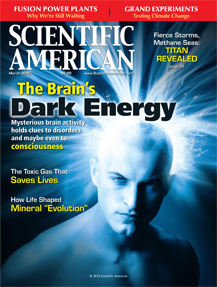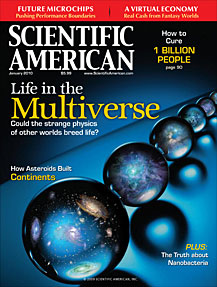April 1, 2010
How the brain produces the sense of someone present when no one is there
In the 1922 poem The Waste Land, T. S. Eliot writes, cryptically: Who is the third who always walks beside you? / When I count, there are only you and I together / But when I look ahead up the white road / There is always another one walking beside you.
In his footnotes to this verse, Eliot explained that the lines “were stimulated by the account of one of the Antarctic expeditions [Ernest Shackleton’s] … that the party of explorers, at the extremity of their strength, had the constant delusion that there was one more member than could actually be counted.”
Third man, angel, alien or deity — all are sensed presences, so I call this the sensed-presence effect. In his gripping book, The Third Man Factor (Penguin, 2009), John Geiger documents the effect in mountain climbers, solo sailors and ultraendurance athletes. He lists conditions associated with it: monotony, darkness, barren landscapes, isolation, cold, injury, dehydration, hunger, fatigue and fear. I would add sleep deprivation; I have repeatedly experienced its effects and witnessed it in others during the 3,000-mile nonstop transcontinental bicycle Race Across America. Four-time winner Jure Robic, a Slovenian soldier, recounted to the New York Times that during one race he engaged in combat a gaggle of mailboxes he was convinced were enemy troops; another year he found himself being chased by a “howling band” of black-bearded horsemen: “Mujahedeen, shooting at me. So I ride faster.” (continue reading…)
March 1, 2010
Obscurantism and obfuscation on national television
Have you ever died and come back to life? Me neither. No one has. But plenty of people say that they have, and their experiences were the subject of an episode of Larry King Live last December on which I appeared as the token skeptic among a tableful of believers, including CNN’s medical correspondent Sanjay Gupta, New Age author Deepak Chopra, a football referee who “died” on the playing field, and an 11-year-old boy named James Leininger who believes he is the reincarnation of a World War II fighter pilot.
Dr. Gupta started us off by recalling that when he was in medical school the residents were taught to mark the time of death to the minute, when death can often take anywhere from a couple of minutes to a couple of hours to occur, depending on the conditions. As Gupta noted, people who have fallen into frozen lakes and “died” were not quite dead, and their core body temperatures dropped so rapidly that their vital tissues were preserved long enough for subsequent resuscitation. In other words, people who have near-death experiences (NDEs) are not actually dead! (continue reading…)
February 1, 2010
How a lack of control leads to superstition
and what can be done about it
Imagine a time in your life when you felt out of control—anything from getting lost to losing a job. Now look at the Figure 1 on this page. What do you see? Such a scenario was presented to subjects in a 2008 experiment by Jennifer Whitson of the University of Texas at Austin and her colleague Adam Galinsky of Northwestern University . Their study, entitled “Lacking Control Increases Illusory Pattern Perception,” was published in Science.
Defining “illusory pattern perception” (what I call “patternicity”) as “the identification of a coherent and meaningful interrelationship among a set of random or unrelated stimuli … (such as the tendency to perceive false correlations, see imaginary figures, form superstitious rituals, and embrace conspiracy beliefs, among others),” the researchers’ thesis was that “when individuals are unable to gain a sense of control objectively, they will try to gain it perceptually.” As Whitson explained the psychology to me, “Feelings of control are essential for our well-being—we think clearer and make better decisions when we feel we are in control. Lacking control is highly aversive, so we instinctively seek out patterns to regain control—even if those patterns are illusory.” (continue reading…)
January 1, 2010
How optimism trumped realism in the positive-psychology movement
I am, by nature, an optimist. I almost always think things will turn out well, and even when they break I am confident that I can fix them. My optimism, however, has not always served me well. Twice I have been hit by cars while cycling— full-on, through-the-windshield impacts that were entirely the result of my blissful attitude that the street corners I had successfully negotiated hundreds of times before would not suddenly materialize an automobile in my path. Such high-impact, unpredictable and rare events are what author Nassim Nicholas Taleb calls “black swans.” Given enough time, no upward sloping trend line is immune from dramatic collapse.
A bike crash as a black swan is, in fact, an apt metaphor for what the investigative journalist and natural-born skeptic Barbara Ehrenreich believes happened to America as a result of the positive-thinking movement. In her engaging and tightly reasoned book Bright-Sided (order on DVD Ehrenreich’s lecture at Caltech), she shows how the positive-psychology movement was born in the halcyon days of the 1990s when the economy was soaring, housing prices were skyrocketing, and positive-thinking gurus were cashing in on the motivation business. Academic psychologists, armed with a veneer of scientific jargon, wanted in on the action. (continue reading…)
December 1, 2009
Psychological research reveals how
and why liberals and conservatives differ
Humans are, by nature, tribal and never more so than in politics. In the culture wars we all know the tribal stereotypes of what liberals think of conservatives: Conservatives are a bunch of Hummer-driving, meat-eating, gun-toting, hard-drinking, Bible-thumping, black-and-white- thinking, fist-pounding, shoe-stomping, morally hypocritical blowhards. And what conservatives think of liberals: Liberals are a bunch of hybrid-driving, tofu-eating, tree-hugging, whale-saving, sandal-wearing, bottled-water-drinking, ACLU-supporting, flip-flopping, wishy-washy, namby-pamby bed wetters.
Like many other stereotypes, each of these contains an element of truth that reflects an emphasis on different moral values. Jonathan Haidt, who is a psychologist at the University of Virginia, explains such stereotypes in terms of his Moral Foundations Theory (see www.moralfoundations.org), which he developed “to understand why morality varies so much across cultures yet still shows so many similarities and recurrent themes.” Haidt proposes that the foundations of our sense of right and wrong rest within “five innate and universally available psychological systems” that might be summarized as follows: (continue reading…)






